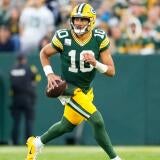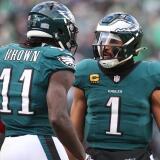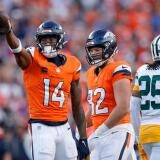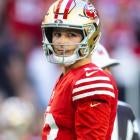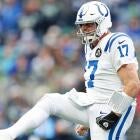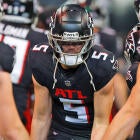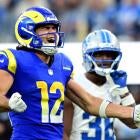2024 NFL preview: C.J. Stroud, Brock Purdy lead young quarterbacks on contenders, rebuilders, in-betweeners
Young quarterbacks open a world of possibilities ... but only if they can deliver first

Welcome to the seventh installation of Thursday Thoughts, a series of looks at key topics across the NFL landscape. We've covered plenty of quarterbacks throughout this summer, and today we're looking at another intriguing group: the young, still-cheap ones.
I don't think I'm delivering any scorching hot take when I say starting quarterback is the most important position in sports. If you have one, you have a chance. If you don't, you don't.
But there's a caveat. When you find a quarterback and he's on a rookie deal, the possibilities are near endless. It allows you to build around him in financial ways you simply can't when he's making top-of-market money.
A quarter of the league's projected Week 1 starters are still on their extremely cheap rookie deals and haven't signed an extension. We've addressed two in this series already: Caleb Williams as a quarterback on team with huge expectations and Anthony Richardson as one of the quarterbacks returning from major injuries. But what about the others? What can they -- and their teams -- do in 2024 to take advantage of their cheapest years? We'll start with one whose team used this offseason to take advantage of his historically great rookie year.
2023 strengths: Just about everything, but especially decision-making, anticipation and big-play production
2023 weaknesses: Pressure mitigation
Wow. Just wow. That's how we can sum up C.J. Stroud's 2023. He threw for 273.9 yards per game and posted 1.0% interception rate. Both were first in the league. The only other players in NFL history to lead both in a season were Tom Brady in 2007 and Joe Montana in 1989, both of whom won MVP in those seasons. And Stroud did it ... as a rookie! His eighth-place MVP finish was simultaneously a marvelous accomplishment and one that didn't do him justice.
Stroud pushed the envelope through the air. Only Will Levis posted more air yards per attempt than Stroud's 9.0. Only Brock Purdy and Jordan Love produced more plays of 25+ yards, and only Tua Tagovailoa produced more plays of 50+ yards.
Where Stroud showed off most with his high-level accuracy and anticipation is over the middle. Look at this throw to Nico Collins.
C.J. Stroud is absurd. pic.twitter.com/ZBaL5TImWj
— Zach Pereles (@zach_pereles) August 21, 2024
Collins isn't even out of his break, and Stroud has a defender barreling down; he doesn't even get a chance to step into this one, yet it's right on the money. The arm talent is ridiculous. Nearly 16% of Stroud's throws over the middle resulted in a gain of 20+ yards, plays like that one above. That's the fifth-highest rate (out of 224 qualified individual seasons) since Pro Football Focus' tracking started in 2017.
Stroud's low interception rate spoke for itself, and he generally did a good job keeping the ball out of harm's way, especially for someone who is so aggressive and so willing to try trick shot throws where his feet aren't perfectly set. Stroud did have six potential interceptions dropped last season, so there's potential for regression. Still, we're picking nits at what was a major strength overall.
Stroud's biggest area for improvement is his response to pressure, even though he could make opponents pay even when under duress thanks to his poise and arm talent.
| C.J. Stroud Last Season | NFL Rank (out of 32) | |
| Sack rate | 7.1% | 23rd |
| Yards lost per sack | 8.7 | 32nd |
| Sacks per pressure rate | 19.6% | 23rd |
| Expected points added per dropback when pressured | -0.44 | 23rd |
In his worst game of the season, a 30-6 loss to the Jets, Stroud was an abysmal 2 for 9 for 19 yards with four sacks (and two interceptions dropped) when pressured. Overall, when Stroud took sacks, they were really damaging ones in terms of yards lost, too. His tendency to drift backward to try to escape pressure and make a second-reaction play was a leading cause for that.
you don't wanna see @Bryce55H comin' at you like this!!#HOUvsNYJ on CBS pic.twitter.com/JOqHPOPeSv
— New York Jets (@nyjets) December 10, 2023
Still, we're talking about one of the best rookie seasons ever, and the Texans are taking advantage. They added Stefon Diggs to join Collins and Tank Dell at wide receiver. They signed Joe Mixon to be a bell cow. They juiced up their pass rush with Danielle Hunter opposite Will Anderson Jr. Denico Autry and Azeez Al-Shaair joined the defensive front seven as well.
Houston was 19th in cap spending last year. It is 10th this year, with upper-half rankings at every position except linebacker. It's exactly how a team should be built when it has an elite, cheap quarterback. The Texans have their best team in a long, long time -- probably ever -- and its outstanding young quarterback is making it possible.
2023 strengths: That it's over
2023 weaknesses: Basically everything
We generally look at Trevor Lawrence's nightmare 2021 as just about the worst it can get for a rookie franchise quarterback in recent memory, but Young gave Lawrence a run for his money. The Panthers assembled a big-name coaching staff that never melded. Play calling duties pinged back and forth. Young's receiving corps and offensive line were among the worst in the league. The running game ranked 28th out of 32 teams in expected points added ... and was probably the bright spot.
So let's wipe the slate clean for Young. He has a new coach (Dave Canales), two new top wide receivers (Diontae Johnson and Xavier Legette), a new running back (Jonathan Brooks, eventually) and two new big-money -- and just big, period -- guards (Damien Lewis and Robert Hunt).
Two of Young's biggest strengths coming out of Alabama were his poise and his ability to create. Across the 2021 and 2022 seasons, he took a sack on 14.4% of the dropbacks he was pressured, 14th out of 60 qualified Power Five quarterbacks, and his 8.4 yards per attempt when pressured was seventh. He had a preternatural calm about him, and when you combined that with his excellent processing and strong accuracy, he was a worthy No. 1 pick.
But things weren't quite the same in the NFL. Not close. He was sacked on 24.6% of the dropbacks he was pressured -- worst in the league -- and his 4.0 yards per attempt when pressured also ranked last. (Spoiler alert: There's a lot of "last" in Young's rookie-year statistical profile.)
Here's where Canales should help. He turned around the careers of both Geno Smith and Baker Mayfield thanks to improvement in this exact area. Mayfield was sacked on roughly 30% of his pressured dropbacks from 2021-22. That fell to 18% last year. Young had to adjust to the speed of the NFL -- where he couldn't escape pressure like he could in college -- behind an awful line with receivers who couldn't get open.
Now, there's legitimate help. Last year, Carolina had exactly one player in ESPN's "open" ranking for pass catchers: Adam Thielen at 37th. Enter Johnson, who was 12th in the metric. Last year, Carolina had zero wide receivers in the top 100 of ESPN's "YAC" ranking. Thielen was best ... at 124th. Enter Legette, who can stretch the field and be a terror after the catch when given a crease.
There are, of course, things Young can't change that are concerning. He's small. He doesn't have great arm strength. While a good and creative athlete, he's not an explosive one. We'd probably describe him more as "slithery." But everything was so condensed in last year's attack that he couldn't really slither anywhere. When he could, he made things happen; his 8.4 yards per scramble ranked fifth in the NFL.
Combine Young's experience with a better supporting cast and better coaching, and there's reason to believe in better results.
2023 strengths: Aggressive mindset
2023 weaknesses: Negative plays
Remember when we talked about Stroud's big-game hunting? Levis is even more aggressive. His average throw last year went over 10 yards downfield, highest in the NFL. Over 22% of his throws went more than 20 yards downfield, also most in the NFL. Levis will stand in there and rip it. Only Justin Fields had a higher percentage of throws in which he held the ball for at least three seconds. Encouragingly, Levis did so while posting the NFL's seventh-lowest interception rate (though some dropped interceptions helped -- maybe he's throwing it too hard for defenders to catch.)
But Levis' fearlessness is a double-edged sword. He was pressured on nearly 45% of his throws and sacked on nearly 10% of them, both among the most in the NFL. He wasn't a particularly effective scrambler, either, which led to a 13.4% negative play rate; only Fields and Zach Wilson were worse.
To be fair, much like Young, Levis operated under far less-than-ideal circumstances. The line was atrocious; it now has two new crucial pieces in first-round pick JC Latham at left tackle and Lloyd Cushenberry at center, and mastermind Bill Callahan coaching it. The receiving corps was underwhelming outside of DeAndre Hopkins; it now has Calvin Ridley and Tyler Boyd as well.
2023 strengths: Added big-play potential to excellent scheme
2023 weaknesses: Recklessness
Yes, Purdy is still on his rookie deal, and what sort of extension he'll get will be fascinating. He is partly a product of the 49ers' excellent environment, but he has also pushed that very environment to new heights. Purdy's willingness and ability to throw downfield has unlocked a new dimension, especially when compared to his predecessor, Jimmy Garoppolo.
Brock Purdy vs. Jimmy Garoppolo on throws 20+ yards downfield with 49ers | Purdy | Garoppolo |
Completion rate | 52% | 35% |
TD-Int | 11-2 | 13-15 |
Off-target rate | 16% | 29% |
Play action rate | 27% | 39% |
The first three categories establish Purdy is much better, dispelling the notion that anyone could put up Purdy's numbers in Kyle Shanahan's offense. The last line, though, is key: Purdy can make these throws without having to lean on play action. The 49ers' straight dropback game, as a result, has flourished. And because Purdy has some playmaking ability, he can bail his team out on the rare occasion things go awry.
Because he can be a little bit of a gambler/freelancer, Purdy can get burned, too. He had the infamous four-turnover game against the Ravens in Week 16 and had three giveaways in Week 8 against the Bengals. While his arm strength has improved, he doesn't have the rocket arm to make every throw, and when he pushes things a smidge too much, he can get in trouble.
Overall, though, Purdy was historically efficient. He has gone from Mr. Irrelevant to one of the most relevant players in the NFL. Expect more of the same this season.
Daniels has done nothing but impress in his short time with the Commanders. A remarkably smooth athlete with some real giddy-up as a runner, Daniels is an exceptionally accurate passer, too. Roughly 10% of his passes last year were deemed off-target by PFF, a terrific number for someone who airs the ball out as much as he did. While it helped that he had two first-round receivers next to him at LSU, Daniels' accuracy helped massively in the YAC game, too; only five FBS players had more YAC per completion than Daniels.
Daniels put up video game numbers (50 total touchdowns, four interceptions) and is a player with video game-esque attributes. But handling pressure will be a big deal, and it was the biggest knock on him coming out of college. He was sacked on over 20% of his pressured dropbacks in his Heisman-winning 2023. The year before, he was at an astounding 31%. So on one hand he made progress, but on the other, it's a problem that goes back a bit.
The Commanders have an uncertain offensive line and, outside of Terry McLaurin, an uncertain receiving room. The early returns have been very strong through two preseason games, but it's been a lot of quick stuff (and, of course, a very small sample size). Daniels has averaged under two seconds to throw. The fastest last year was Tagovailoa at 2.35. Long story short, outside of the accuracy, there's not a ton we can take away in regards to his biggest area of concern in college ... yet.
Nix has impressed this preseason. He excelled at Oregon as a player who is accurate in a precise, rhythm-based offensive attack, and that's exactly what Sean Payton wants from his quarterbacks. He's also a solid athlete who can make things happen out of structure, though that's not something he or Payton want to see too much.
Last year, a stunning 6% of Nix's passes were considered off-target. That's second-best in PFF's database, which goes back to 2016. However, take that number with a grain of salt: Nix averaged just 6.6 yards downfield, an extremely low number. Relying heavily on the quick, short passing game is great until you get behind the chains and have to make a big-time throw against pressure. Nix was blitzed at the third-lowest rate in FBS last year.
Where Nix must prove himself -- or at least show signs of promise -- is on those big throws over the middle. Nearly 24% of Nix's throws at least 20 yards downfield and between the numbers were off-target. Compare that to 16% for Drake Maye, 14% for Daniels, 11% for Williams and 4% for J.J. McCarthy, four of the five other first-round quarterbacks this year.
Nix could have some success in Payton's preferred scheme. When he has to expand beyond the bread and butter, though, it'll be a much bigger test.
More Thursday Thoughts:
Part 1: Can Caleb Williams and the Bears deliver on high expectations?
Part 2: Is this the Cowboys' last run as we know them?
Part 3: How will quarterbacks returning from season-ending injuries fare?
Part 4: What happens in the AFC North, the league's best and most intriguing conference?
Part 5: Is it the new-look Bills' time to break through?
Part 6: How will big-name running backs impact their new teams?















